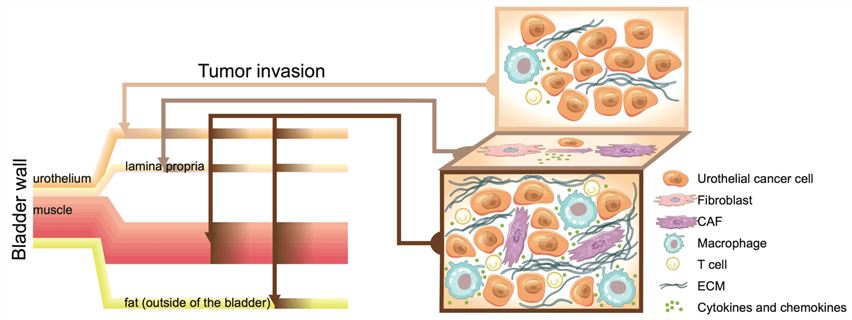With years of experience in developing antibodies for analytical research and diagnostic applications, Creative Biolabs specializes in custom antibody and assay development for the diagnosis of a variety of diseases and infections. Particularly, we provide high-quality in vitro diagnostic (IVD) antibody development services for the diagnosis of different cancers, such as bladder cancer.
Introduction of Bladder Cancer
Bladder cancer is the commonest malignancy of the urinary tract, accounting for 7 percent of all cancers in men and 2 percent of those in women. The main symptoms of bladder cancer include blood in the urine, pain with urination and low back pain. Although the accurate cause remains unclear, risk factors that may contribute to its development include cigarette smoking, occupational exposure to chemicals such as aniline dyes and aromatic amines, consumption of analgesics containing phenacetin, chronic infection or irritation of the bladder, and chemotherapeutic agents such as cyclophosphamide. Over 90% of malignant tumors of the bladder are 'urothelial' transitional cell carcinoma (TCC). Less common forms of bladder cancer include squamous cell carcinoma, adenocarcinoma, and neuroendocrine tumors. The grading and staging of bladder cancer use the TNM (tumor, nodes, metastases) classification system, which provides important information for disease prognosis and prediction.
 Fig.1 Bladder cancer tumors break through the bladder.1
Fig.1 Bladder cancer tumors break through the bladder.1
Diagnosis of Bladder Cancer
The diagnosis and classification of bladder cancer are important to determine the appropriate treatment strategy and predict outcomes. The cornerstone of diagnosis of bladder cancer is the cystoscopic examination of the lower urinary tract, and the white light cystoscopy (WLC) remains the gold standard. Recently, new optical diagnostic methods have been designed to improve the accuracy of WLC: fluorescence cystoscopy, narrow-band imaging, and optical coherence tomography. To identify lesions within the ureter, renal pelvis and renal parenchyma, medical imaging techniques such as ultrasonography, intravenous urogram or computed tomography (CT) may also be applied. Moreover, urine cytology can be a useful test for diagnosing high-grade disease.
Diagnostic Tumor Markers
Cystoscopy and urine cytology is currently the gold standard in the diagnosis and follow-up of bladder cancer, yet still exhibit limited sensitivity, leading to the development of more advanced tests for the identification and surveillance of bladder cancer, such as the development of diagnostic tumor markers. For example, tumor-associated antigens that can be detected in both voided urine samples and tissue sections have been investigated for their potential diagnostic use. As a result, a number of monoclonal antibodies have been produced and some of them prove to have clinical value. Currently, BTA, BTA stat, BTA trak and Immunocyt test are approved by the Food and Drug Administration. These test systems have presented promising capabilities, indicating a higher sensitivity than urine cytology to detect primary and recurrent bladder tumors. Hence, there is reason to believe that in the future, rather highly sensitive tests can be developed and may be able to replace cytology as an adjunct to cystoscopy or to replace cystoscopy itself in the follow-up of selected patients.
In order to improve human health globally, Creative Biolabs' mission is to provide extensive expertise in the development of valuable antibodies for diagnostic use to support our clients. With our versatile IVD platform, Creative Biolabs is proud to develop novel biomarker-specific (paired) antibodies from scratch to commercial IVD kit (we can also start with provided antibody candidates). We are proud to share this expertise and our state-of-the-art facilities to facilitate their brilliant studies. Moreover, every project can be customized to meet your specific needs.
Potential biomarkers for bladder cancer development include but are not limited to:
Reference
- Pan, Shen, et al. "Immune status for monitoring and treatment of bladder cancer." Frontiers in Immunology 13 (2022): 963877. Distributed under Open Access license CC BY 4.0, without modification.
For Research Use Only.

